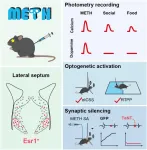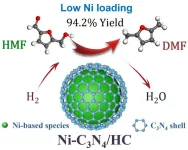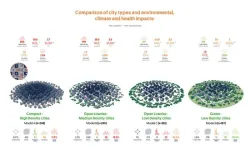(Press-News.org) Findings published in a new peer-reviewed paper in the British Journal of Educational Studies challenges the idea that academically selective schools are necessary for clever pupils to achieve good outcomes.
Selective schools are government-funded schools that enrol only the highest performing students. Pupils take a standardized entrance exam, from which the best-scoring are enrolled.
Some argue that selective schools are necessary for bright pupils to reach their full academic potential. Selective schools can outperform or perform just as well as elite schools in final year exams, but without the high fees charged to parents. Hence, selective schools can offer a means for children from low socioeconomic backgrounds to receive a first-class education.
However, others argue that selective schools disproportionately benefit high socioeconomic children whose parents can afford private tutoring to prepare them for the entrance exams.
“Studies show that parents wish to enrol their children into selective schools, because they believe it will increase the chances of their children getting into a prestigious university, and securing a well-paid and high-status job,” says Melissa Tham, a research fellow at the Mitchell Institute at Victoria University, Melbourne, Australia.
To find out whether there are benefits associated with selective schools, Tham and her colleagues Shuyan Huo, and Andrew Wade tracked almost 3000 pupils from the Longitudinal Surveys of Australian Youth (LSAY), a nationally representative survey program that follows young Australians over an 11-year period. The survey started when respondents were aged 15 in 2009.
As expected, the selective schools featured in the study had a higher proportion of academically high-achieving students, as measured by mathematics and reading scores.
However, at ages 19 and 25 there was little difference between the educational and employment outcomes of children who attended selective schools versus non-selective schools. For example, the study found that while 81% of selective school students went on to secure a job or university place at 19 compared to 77.6% of pupils from non-selective schools, this difference disappeared when the students were matched on key characteristics, including socioeconomic background, gender, and geographical location.
At age 25, all outcomes between selective and non-selective school students were not significant, except general life satisfaction. Attending a selective school increased a student’s general life satisfaction score by just 0.19 points. Meanwhile, students who attended non-selective school were just as likely to go on to study at university or secure a job as their peers who attended selective schools.
“These very modest findings indicate that attending an academically selective school does not appear to pay off in large benefits for individuals,” says Andrew Wade, co-author of the study.
“We argue that academically selective schools in the government sector therefore contradicts the principles of inclusive and equitable education which underpin Australia’s school system.”
According to the authors, the findings suggest that more research is needed to determine whether selective schools offer any benefit to academically able students.
“Rather than tweak some aspects of the enrolment processes, we see greater value in conducting a thorough and critical examination of fully and partially selective schools, and scaling back selectivity if the supposed benefits are not found,” says Huo.
END
Clever pupils don’t need to attend academically selective schools to thrive, study finds
2024-07-04
ELSE PRESS RELEASES FROM THIS DATE:
Searching for dark matter with the coldest quantum detectors in the world
2024-07-04
One of the greatest mysteries of science could be one step closer to being solved.
Approximately 80% of the matter in the universe is dark, meaning that it cannot be seen. In fact, dark matter is passing through us constantly – possibly at a rate of trillions of particles per second.
We know it exists because we can see the effects of its gravity, but experiments to date have so far failed to detect it.
Taking advantage of the most advanced quantum technologies, scientists from Lancaster University, the University of Oxford, and Royal Holloway, ...
UNSW Sydney's Dr Vaishnavi Ananthanarayanan receives RMS Award for Life Sciences
2024-07-04
This accolade highlights her pioneering research in the use of a diverse array of advanced microscopy techniques to uncover fundamental biophysical processes.
Currently holding a prestigious EMBL (European Molecular Biology Laboratory) Australia Group Leader fellowship, Dr Ananthanarayanan leads one of the largest and most dynamic research group in the EMBL Australia Node in Single Molecule Science, based in the Department of Molecular Medicine in the School of Biomedical Sciences.
Her research, which focuses on motor proteins and cytoskeleton dynamics, has set new standards ...
Researchers unveils a critical role of the lateral septum in drug addiction
2024-07-04
Recently, a research team led by Dr. ZHU Yingjie from the Shenzhen Institute of Advanced Technology, Chinese Academy of Sciences has published a study in Neuron, the study presents a comprehensive transcriptional profile of the lateral septum (LS) at the single-cell level, elucidating the spatial distribution of its major neuronal types. The study shows that neurons expressing estrogen receptor 1 (LSEsr1), predominantly located in the ventral subregion of LS, play a crucial role in reward-seeking and methamphetamine (METH) addiction.
In 1954, psychologists Olds and Milner discovered the brain's reward system through intracranial ...
Efficient hydrogenolysis of 5-hydroxymethylfurfural over Ni-C3N4 catalysts
2024-07-04
Utilization of biomass as the basic feedstock for the production and chemicals and energy storage has been demonstrated to be an important alternative to achieve sustainable society, which has attracted increasing interests in both academic and industrial communities for decades. 5-hydroxymethylfurfural (HMF), one of the most important bio-based platform compounds, could serve as a bridge feedstock between biomass resources and chemicals. It is possible to synthesize a series of high-value added chemicals from HMF through hydrogenation, ...
Hitachi’s holography electron microscope attains unprecedented resolution
2024-07-04
Tokyo, Japan—A research team from Japan, including scientists from Hitachi, Ltd. (TSE 6501, Hitachi), Kyushu University, RIKEN, and HREM Research Inc. (HREM), has achieved a major breakthrough in the observation of magnetic fields at unimaginably small scales. In collaboration with National Institute of Advanced Industrial Science and Technology (AIST) and the National Institute for Materials Science (NIMS), the team used Hitachi’s atomic-resolution holography electron microscope—with a newly developed image acquisition technology and defocus correction algorithms—to visualize ...
An innovative test to diagnose chagas disease in newborns
2024-07-04
An innovative test that combines a DNA extraction system inspired by a modified 3D printer (PrintrLab) with loop-mediated isothermal molecular amplification (LAMP) could be used to detect T. cruzi infection -responsible for Chagas disease- in newborns. This is the conclusion of a proof-of-concept study conducted in the Bolivian Chaco, an endemic area for Chagas disease. The study was coordinated by the Barcelona Institute for Global Health (ISGlobal), a centre supported by "la Caixa" ...
Compact cities have lower carbon emissions, but poorer air quality, less green space and higher mortality rates
2024-07-04
What types of cities exist in Europe and which are more favourable in terms of human health, environmental quality and carbon footprint? To answer these questions, a study led by the Barcelona Institute for Global Health (ISGlobal), a centre supported by the "la Caixa" Foundation, has analysed 919 European cities. The research, published in The Lancet Planetary Health, identified four basic urban configurations on the continent: compact-high density cities, open lowrise-medium density cities, open lowrise-low density cities and green-low density cities. The results show that greener and less densely populated ...
Cuts to processed meat intake bring a range of health benefits
2024-07-04
Reducing consumption of processed meat by around one-third could prevent more than 350,000 cases of diabetes in the US over 10 years, a study suggests.
Cutting US adults’ processed meat intake by 30 per cent – the equivalent of around 10 slices of bacon a week – would also lead to tens of thousands of fewer cases of cardiovascular disease and colorectal cancer, researchers say.
A team from the University of Edinburgh’s Global Academy of Agriculture and Food Systems together with the University of North Carolina, Chapel Hill, has developed ...
Pioneering Code of Practice released for use of stem cell-based embryo models in research
2024-07-04
Stem cell-based embryo models (SCBEMs) are three-dimensional biological structures that mimic aspects of early human embryo development. They can be created in the lab from stem cells, and can provide new insights into critical stages of early human development that are normally inaccessible to researchers.
Embryo model work is expected to lead to new interventions for a range of conditions, including revolutionising treatments for recurrent miscarriage, understanding developmental disorders and improving the success rate of IVF.
Although embryo models are not the same ...
First study to measure toxic metals in tampons shows arsenic and lead, among other contaminants
2024-07-04
Tampons from several brands that potentially millions of people use each month can contain toxic metals like lead, arsenic, and cadmium, a new study led by a UC Berkeley researcher has found.
Tampons are of particular concern as a potential source of exposure to chemicals, including metals, because the skin of the vagina has a higher potential for chemical absorption than skin elsewhere on the body. In addition, the products are used by a large percentage of the population on a monthly basis—50-80% of those who menstruate use tampons—for several hours at a time.
“Despite this large potential for public health concern, very little research ...






